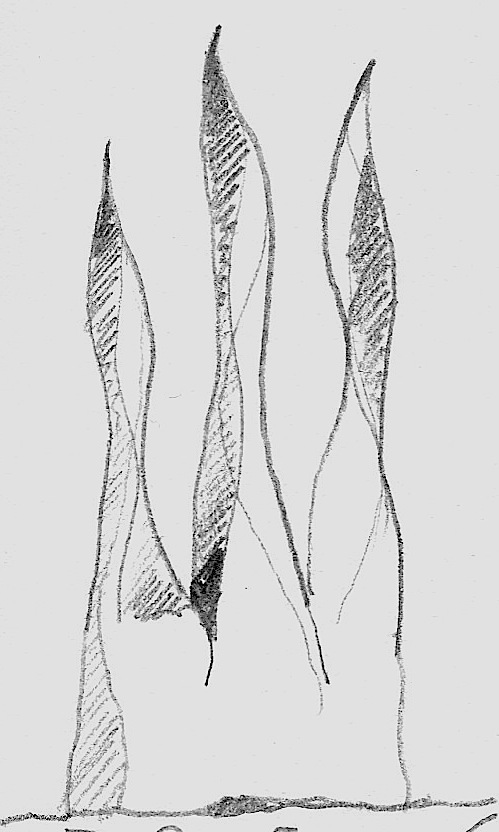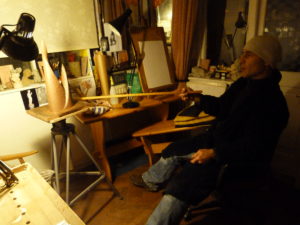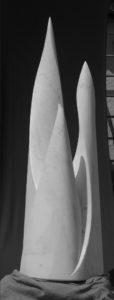Forming The Idea
 The concept for my current piece grew over a period of time. I can remember more than a year ago having a feeling for flame-like forms and sketching them. Some time later, I saw a documentary on archaeology where I learned the importance of the beautiful symbol of the triskelion: the interconnected three-legged spiral. Still later I became interested in the quirky philosophy of Soren Kierkegaard and, becoming aware of connections between it and the triskelion symbolism, a synthesis occurred between this and my previous flame shapes idea. After a number of sketches this lead to my current design. For a more detailed description of how, in this case, philosophy and sculpture go hand in hand please see the Tab: “Philosophy and Sculpture”.
The concept for my current piece grew over a period of time. I can remember more than a year ago having a feeling for flame-like forms and sketching them. Some time later, I saw a documentary on archaeology where I learned the importance of the beautiful symbol of the triskelion: the interconnected three-legged spiral. Still later I became interested in the quirky philosophy of Soren Kierkegaard and, becoming aware of connections between it and the triskelion symbolism, a synthesis occurred between this and my previous flame shapes idea. After a number of sketches this lead to my current design. For a more detailed description of how, in this case, philosophy and sculpture go hand in hand please see the Tab: “Philosophy and Sculpture”.
The process I am following for this piece is fairly typical of my way of working, although actually each idea and block of stone requires a slightly different approach. I do all the work, of all the stages myself. This has the advantage of having full control over the process and of never needing to make adjustments (albeit minor ones) to the sculpture due to someone else’s way of working.
 From the sketches, a detailed maquette is modelled from clay (sometimes with the intermediate step of clay palm-sized “sketches”). A plaster waste-mould is then produced from the clay maquette and a plaster cast from that mould. The original clay maquette is destroyed in the process. The plaster model version of the clay maquette is necessary because, the clay would not usually withstand the daily use during carving as a model for scaling up.
From the sketches, a detailed maquette is modelled from clay (sometimes with the intermediate step of clay palm-sized “sketches”). A plaster waste-mould is then produced from the clay maquette and a plaster cast from that mould. The original clay maquette is destroyed in the process. The plaster model version of the clay maquette is necessary because, the clay would not usually withstand the daily use during carving as a model for scaling up.
The design and model making process is quite lengthy and, for this sculpture, took over eight weeks. It is, however, necessary to ensure satisfactory results, and when the carving of the sculpture takes months or even years, it is not so lengthy relatively speaking.
The stone block must then be procured. In this case, I went to the mountains of Carrara in Italy to select a good block of white marble two tons in weight, over two meters high and approximating the shape of my model, and had it shipped over.
Working The Block
Before one can start cutting stone, both the plaster model and the rough block must be very carefully measured and marked out and, by scaling up accurately by eye and with calipers, the correct orientation and size of the proposed form within the block, determined.
 Carving starts with roughing out where the bulk of the marble is removed with diamond bladed angle grinders and club hammers. This is a laborious, noisy and very dusty process but where utmost precision is necessary to avoid mistakes and wasted effort. It is, however, also satisfying as many kilos of marble are removed quickly. At the end of this stage, if one were carving a human figure, it would look like a mummy case.
Carving starts with roughing out where the bulk of the marble is removed with diamond bladed angle grinders and club hammers. This is a laborious, noisy and very dusty process but where utmost precision is necessary to avoid mistakes and wasted effort. It is, however, also satisfying as many kilos of marble are removed quickly. At the end of this stage, if one were carving a human figure, it would look like a mummy case.
Then follows a sort of secondary roughing out where one goes into the details and interstices of the form with chisel and pneumatic hammer. Now the figure would start having rudimentary features. Finishing then takes place with grinding tools much as a dentist would use and with small chisels, rasps and abrasive paper. This is a very delicate and subtle process, and enjoyable too, as the sculpture finally comes to life.
The finished sculpture must then be transported to the art gallery or client with great care as any projections are delicate.